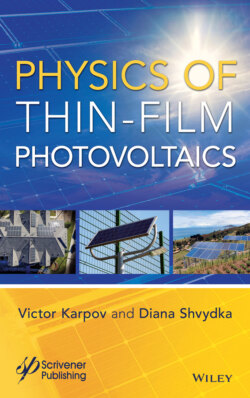Читать книгу Physics of Thin-Film Photovoltaics - Victor G. Karpov - Страница 15
B. Fundamental Material Requirements
ОглавлениеA well known feature of all PV devices is that at least some of their constituting materials must have a not-too-wide forbidden gap, say G ~ 1–2 eV. The origin of that criterion is that larger band gaps exceeding the energies of most of sun spectra photons would not allow efficient light absorption necessary to produce enough electrons and holes. However, there is also the opposite requirement of those gaps being not too small, so that efficiently absorbing narrow band semiconductors are not good for PV either. As a result, semiconductors with substantial but not-too-wide forbidden gaps G ~ 1–2 eV, such as Si, Ge, CdTe, CIGS and some others are most suitable for PV.
The not-too-narrow gap limitation is less intuitive and may be worth explaining here. It is dictated by PV functionality as a power source. The power is a product of electric current and voltage, P = IV where both I and V components must be not too small. I is proportional to the light induced charge generation rate favoring significant absorption coefficients in the sun spectral region of ħω ~ 0.5–2 eV. Forbidden gaps G ~ 1–2 eV of many semiconductors fall in that region. To the contrary, the typical dielectric gaps G ≳ 4 eV are too wide for sufficient absorption (for example, window glass that is practically transparent and does not absorb light).
The requirement that undermines the suitability of narrow gap semiconductors (despite their strong absorption coefficients) is related to the voltage component: V ≤ G/q, where q is the electron charge. To explain the latter inequality we note that V can be related to the difference in Fermi energies in two metal electrodes as illustrated in Fig. 2. We recall that the Fermi (quasi-Fermi) energy describes the energy change due to removing one particle from the system. Therefore, ΔEF ≡ EF1 − EF2 gives the energy change due to transferring one electron between the two metals, and so does qV. On the other hand, the metal Fermi energies must not overlap with the semiconductor conduction or valence bands because such an overlap would mean that the semiconductor has in reality metal conductivity (no gap between the Fermi level and forbidden gap edges). As illustrated in Fig. 2, G presents the upper limit of the difference between the electron and hole Fermi levels allowing their steady state spatial separation. Increasing V beyond G/q would shift the Fermi levels beyond the forbidden gap turning the semiconductor into metal thus shorting the built in field and the circuit.
Fig. 2 Band diagram of a metal/semiconductor/metal structure where EF1 and EF2 represent quasi-Fermi levels determined by voltage drop V across the semiconductor.
Another wording of the same is that electrons and holes recombine very efficiently when the two Fermi levels are close thus suppressing their spatial separation and the built-in field. Assuming point defect mediated recombination, it can be shown more quantitatively [12] that the electron-hole recombination rate strongly accelerates with decrease of the gap G. As a result, there exists a range of gaps optimizing PV performance, G ≲ 2 eV. It should be remembered however, that the latter optimum gap prediction was derived under certain assumptions about the nature of (defect facilitated) recombination, lack of traps, insignificant leakage due to shunts, and others clearly outlined in the original work [12].
